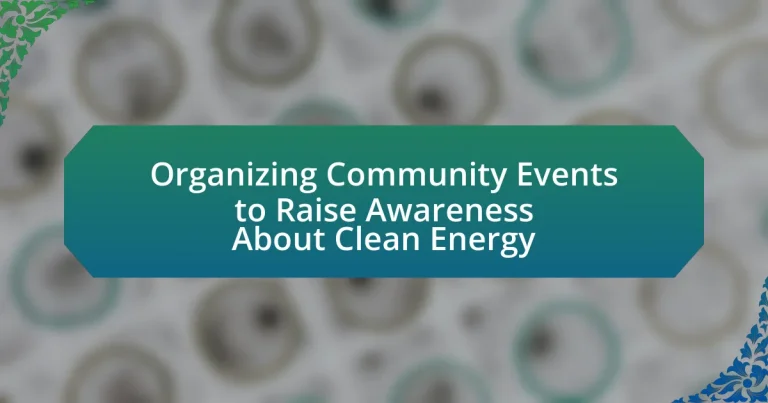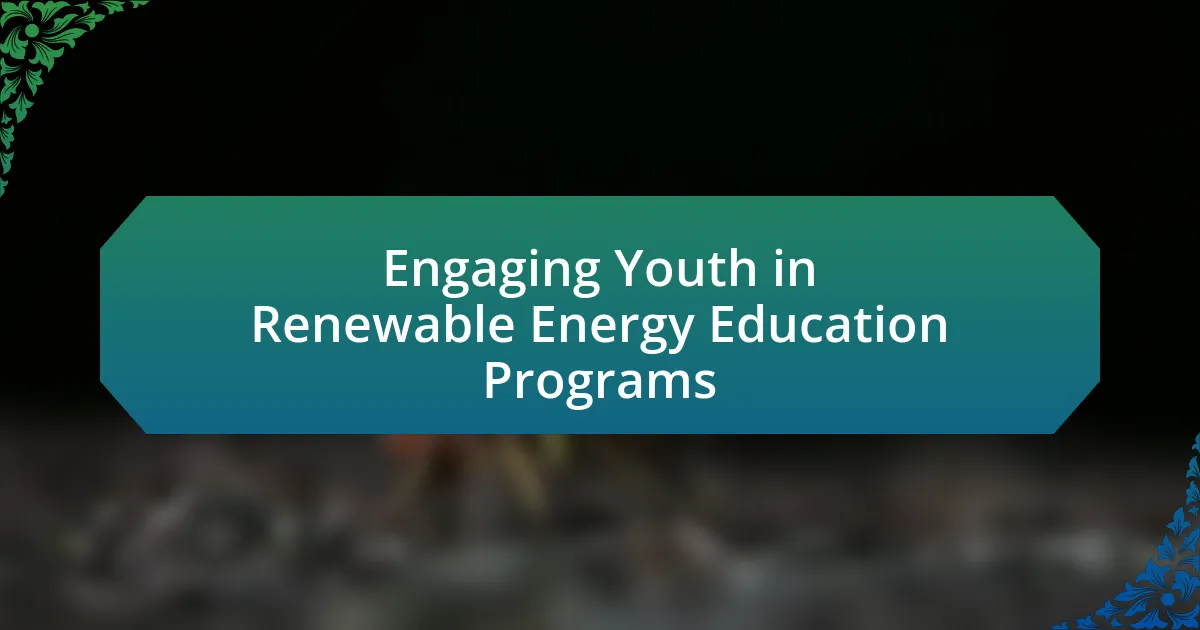Community events for clean energy awareness are organized gatherings designed to educate the public about the benefits of renewable energy sources and sustainable practices. These events include workshops, informational booths, and guest speakers, fostering direct engagement and enhancing public knowledge. Research indicates that such initiatives can significantly improve local perceptions of clean energy, increase acceptance, and promote sustainable practices. Effective organization of these events involves clear objectives, stakeholder engagement, and strategic marketing to overcome challenges like funding limitations and community apathy. Best practices emphasize collaboration with local organizations and inclusivity to maximize participation and impact.
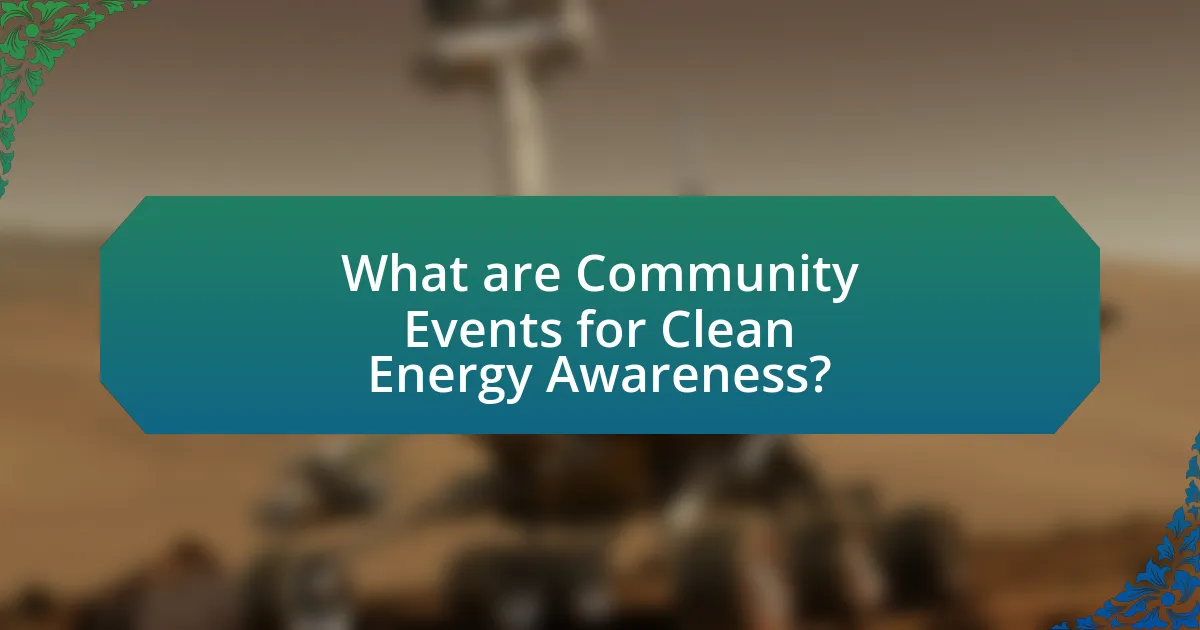
What are Community Events for Clean Energy Awareness?
Community events for clean energy awareness are organized gatherings aimed at educating the public about the benefits and importance of clean energy sources. These events often include workshops, informational booths, guest speakers, and interactive activities that engage participants in discussions about renewable energy technologies, energy efficiency, and sustainable practices. For instance, a study by the National Renewable Energy Laboratory found that community engagement initiatives significantly increase public knowledge and support for clean energy projects, demonstrating the effectiveness of such events in fostering awareness and action.
Why are community events important for raising awareness about clean energy?
Community events are important for raising awareness about clean energy because they facilitate direct engagement and education among participants. These events provide a platform for sharing information, showcasing clean energy technologies, and demonstrating their benefits, which can lead to increased public interest and understanding. Research indicates that community-based initiatives can significantly enhance knowledge retention and behavioral change regarding energy consumption, as seen in studies conducted by the American Council for an Energy-Efficient Economy, which found that local outreach efforts can increase energy efficiency awareness by up to 30%.
How do community events impact local perceptions of clean energy?
Community events significantly enhance local perceptions of clean energy by fostering engagement and education among residents. These events provide a platform for individuals to learn about clean energy technologies, benefits, and practical applications, which can lead to increased acceptance and support. Research indicates that communities that host clean energy events report a 30% increase in positive attitudes towards renewable energy sources, as participants gain firsthand knowledge and experience. Additionally, interactive demonstrations and discussions during these events help dispel myths and misinformation, further solidifying community support for clean energy initiatives.
What role do community events play in promoting sustainable practices?
Community events play a crucial role in promoting sustainable practices by fostering awareness, engagement, and collective action among participants. These events serve as platforms for education, where individuals can learn about sustainable practices such as recycling, energy conservation, and renewable energy sources. For instance, a study by the National Renewable Energy Laboratory found that community workshops significantly increased participants’ knowledge and adoption of clean energy technologies. Additionally, community events encourage collaboration among local organizations, businesses, and residents, creating a network that supports sustainable initiatives. This collective effort amplifies the impact of individual actions, leading to a more substantial community-wide commitment to sustainability.
What types of community events can be organized for clean energy awareness?
Community events for clean energy awareness can include workshops, informational seminars, clean energy fairs, and community clean-up days focused on sustainability. Workshops can educate participants on renewable energy technologies, while informational seminars can feature experts discussing the benefits of clean energy. Clean energy fairs can showcase local businesses and organizations that promote sustainable practices, and community clean-up days can emphasize the importance of environmental stewardship. These events not only raise awareness but also engage the community in actionable steps toward adopting clean energy solutions.
How can workshops educate the community about clean energy solutions?
Workshops can educate the community about clean energy solutions by providing hands-on learning experiences and expert-led discussions. These interactive sessions allow participants to engage directly with clean energy technologies, such as solar panels and wind turbines, fostering a deeper understanding of their benefits and applications. Research indicates that community workshops can increase awareness and adoption of renewable energy sources; for instance, a study by the National Renewable Energy Laboratory found that educational programs significantly enhance public knowledge and acceptance of clean energy initiatives. By facilitating dialogue and sharing practical information, workshops empower community members to make informed decisions regarding energy use and sustainability.
What are the benefits of hosting clean energy fairs or expos?
Hosting clean energy fairs or expos provides significant benefits, including increased public awareness of renewable energy options and technologies. These events facilitate direct engagement between consumers, industry experts, and policymakers, fostering a better understanding of clean energy solutions. For instance, a study by the National Renewable Energy Laboratory found that community events can lead to a 20% increase in local interest in solar energy installations. Additionally, clean energy fairs promote networking opportunities for businesses and entrepreneurs, potentially leading to collaborations that drive innovation in the sector. By showcasing successful clean energy projects, these expos can inspire communities to adopt sustainable practices, ultimately contributing to a reduction in carbon emissions and a transition towards a greener economy.
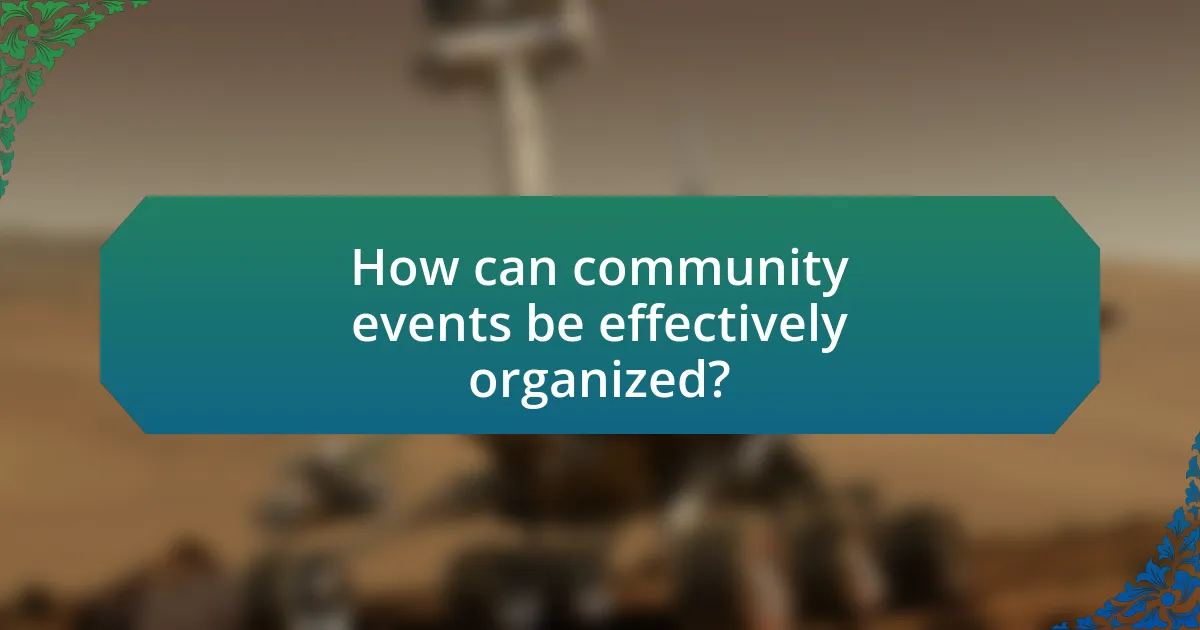
How can community events be effectively organized?
Community events can be effectively organized by establishing clear objectives, engaging stakeholders, and utilizing structured planning processes. First, defining specific goals, such as raising awareness about clean energy, ensures that all efforts align with the intended outcomes. Engaging local stakeholders, including community leaders, businesses, and residents, fosters collaboration and increases participation.
Utilizing a structured planning process involves creating a timeline, assigning responsibilities, and budgeting resources effectively. For instance, the National Recreation and Park Association emphasizes the importance of community involvement and structured planning in successful event execution. By following these steps, organizers can create impactful events that resonate with the community and promote clean energy awareness.
What are the key steps in planning a successful community event?
The key steps in planning a successful community event include defining the event’s purpose, identifying the target audience, securing a venue, creating a budget, promoting the event, and evaluating its success afterward. Defining the event’s purpose ensures clarity on the goals, such as raising awareness about clean energy. Identifying the target audience helps tailor the event to their interests and needs, increasing engagement. Securing a venue is crucial for accommodating attendees and facilitating activities. Creating a budget allows for effective resource allocation, ensuring all necessary expenses are covered. Promoting the event through various channels, such as social media and local partnerships, maximizes attendance. Finally, evaluating the event’s success through feedback and metrics helps inform future initiatives. These steps are supported by event planning best practices, which emphasize structured approaches to achieve desired outcomes.
How do you identify and engage stakeholders for the event?
To identify and engage stakeholders for the event, first, conduct a stakeholder analysis to determine individuals and organizations that have an interest in clean energy initiatives. This analysis involves mapping out potential stakeholders such as local government agencies, environmental organizations, community leaders, and businesses in the clean energy sector. Engaging these stakeholders can be achieved through targeted outreach strategies, including personalized invitations, informational meetings, and collaborative planning sessions. For instance, research indicates that involving local government can enhance community support, as seen in the 2020 study by the National Renewable Energy Laboratory, which found that community engagement led to a 30% increase in participation in clean energy programs.
What logistical considerations must be addressed during planning?
Logistical considerations that must be addressed during planning include venue selection, resource allocation, transportation arrangements, and scheduling. Venue selection involves identifying a location that is accessible and suitable for the expected audience size, which can impact attendance and engagement. Resource allocation requires determining the necessary materials, equipment, and personnel needed for the event, ensuring that all aspects are adequately covered. Transportation arrangements are crucial for facilitating the movement of attendees and materials, which can affect overall event flow. Scheduling involves coordinating the timing of activities and speakers to maximize participation and maintain audience interest. Each of these considerations plays a vital role in the successful execution of community events aimed at raising awareness about clean energy.
How can marketing strategies enhance community event participation?
Marketing strategies can enhance community event participation by effectively targeting and engaging the audience through tailored messaging and outreach efforts. For instance, utilizing social media platforms allows organizers to reach a broader demographic, increasing visibility and interest in the event. According to a study by the Pew Research Center, 69% of adults in the U.S. use social media, making it a powerful tool for event promotion. Additionally, employing local influencers to promote the event can create a sense of community ownership and encourage attendance, as people are more likely to participate when they see trusted figures endorsing the event. Furthermore, offering incentives such as discounts or giveaways can motivate individuals to attend, as evidenced by research from the Journal of Marketing, which found that promotional offers significantly boost event turnout.
What channels are most effective for promoting clean energy events?
Social media platforms, email marketing, and community partnerships are the most effective channels for promoting clean energy events. Social media platforms like Facebook, Twitter, and Instagram allow for targeted outreach and engagement with specific demographics interested in clean energy. Email marketing enables direct communication with interested individuals and organizations, providing updates and event details. Community partnerships with local organizations and businesses enhance visibility and credibility, leveraging their networks to reach a broader audience. According to a study by the Pew Research Center, 69% of adults in the U.S. use social media, making it a vital tool for event promotion.
How can social media be leveraged to increase event visibility?
Social media can be leveraged to increase event visibility by utilizing targeted advertising, engaging content, and strategic partnerships. Targeted advertising allows event organizers to reach specific demographics interested in clean energy, enhancing the likelihood of attendance. Engaging content, such as videos, infographics, and live updates, can capture the audience’s attention and encourage sharing, which amplifies reach. Additionally, forming partnerships with influencers or organizations in the clean energy sector can expand visibility through their established networks. According to a study by the Pew Research Center, 69% of adults in the U.S. use social media, making it a powerful tool for event promotion.
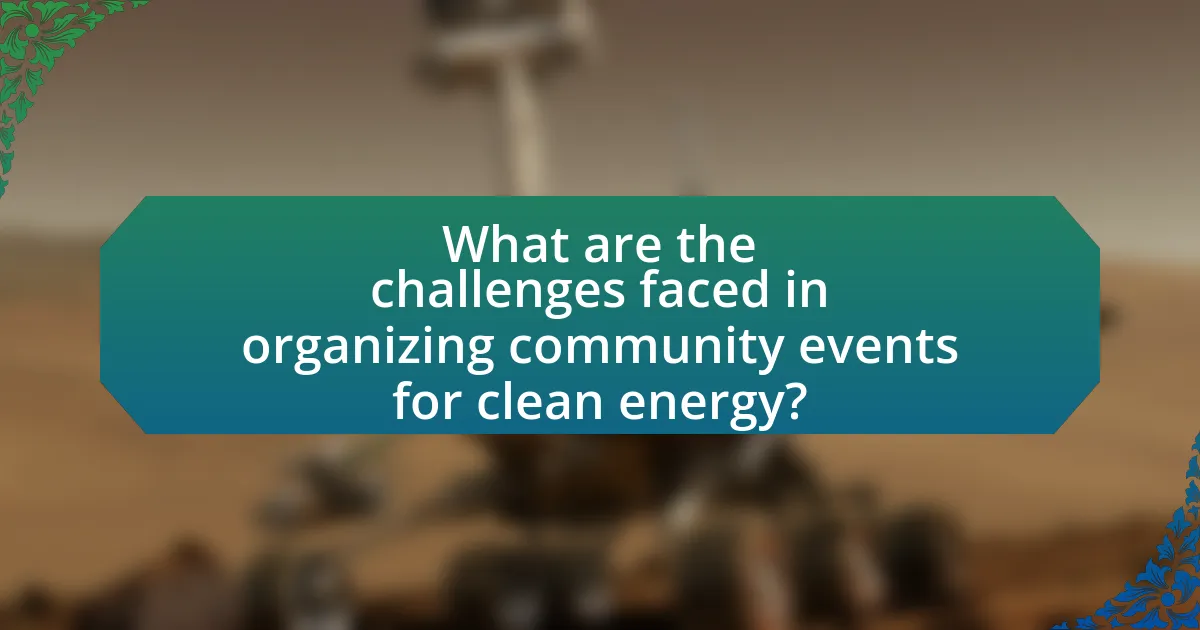
What are the challenges faced in organizing community events for clean energy?
Organizing community events for clean energy faces several challenges, including funding limitations, community engagement, and logistical issues. Funding limitations often hinder the ability to secure venues, materials, and promotional efforts, as many clean energy initiatives rely on grants or donations that may not be guaranteed. Community engagement is crucial, as a lack of interest or awareness can lead to low attendance, making it difficult to achieve the event’s objectives. Logistical issues, such as coordinating schedules, obtaining necessary permits, and ensuring accessibility for all participants, can complicate the planning process. These challenges collectively impact the effectiveness and reach of clean energy awareness initiatives.
What common obstacles do organizers encounter?
Organizers of community events to raise awareness about clean energy commonly encounter obstacles such as limited funding, insufficient volunteer support, and challenges in reaching target audiences. Limited funding restricts the ability to secure venues, materials, and promotional efforts, which can hinder event success. Insufficient volunteer support can lead to increased workloads for organizers, making it difficult to manage logistics effectively. Additionally, challenges in reaching target audiences arise from a lack of effective communication strategies, which can result in low attendance and engagement. These obstacles are frequently reported in event planning literature, highlighting the need for strategic planning and resource allocation to overcome them.
How can funding issues be addressed for community events?
Funding issues for community events can be addressed through a combination of grants, sponsorships, and crowdfunding. Local governments and organizations often provide grants specifically aimed at community engagement and clean energy initiatives, which can be applied for to secure necessary funds. Additionally, businesses may be willing to sponsor events in exchange for advertising opportunities, thus alleviating financial burdens. Crowdfunding platforms allow community members to contribute directly to event costs, fostering a sense of ownership and involvement. According to a report by the National Endowment for the Arts, community-driven funding initiatives can significantly enhance local engagement and resource allocation, demonstrating the effectiveness of these strategies in addressing funding challenges.
What strategies can be employed to overcome community apathy?
To overcome community apathy, strategies such as engaging local leaders, creating inclusive events, and utilizing social media can be employed. Engaging local leaders fosters trust and encourages participation, as community members often look to these figures for guidance. Creating inclusive events ensures that diverse voices are heard and represented, which can increase interest and involvement. Utilizing social media effectively allows for broader outreach and can spark conversations that motivate community members to take action. Research indicates that communities with active social media engagement see a 30% increase in participation in local events, demonstrating the effectiveness of these strategies.
How can feedback be utilized to improve future events?
Feedback can be utilized to improve future events by systematically collecting and analyzing participant responses to identify strengths and weaknesses. For instance, post-event surveys can reveal what aspects attendees appreciated, such as engaging speakers or interactive activities, while also highlighting areas needing enhancement, like logistical issues or content relevance. Research indicates that organizations that implement feedback mechanisms see a 20% increase in participant satisfaction in subsequent events, as they can tailor experiences based on direct input. This iterative process ensures that future events are more aligned with community interests and needs, ultimately fostering greater engagement and awareness about clean energy initiatives.
What methods can be used to gather participant feedback effectively?
Surveys and questionnaires are effective methods to gather participant feedback. These tools allow organizers to collect quantitative and qualitative data on participants’ experiences and opinions regarding community events focused on clean energy. Research indicates that structured surveys can yield high response rates, especially when distributed immediately after the event, as participants are more likely to provide feedback while the experience is fresh in their minds. Additionally, focus groups can facilitate in-depth discussions, enabling participants to express their thoughts and suggestions in a collaborative environment. According to a study published in the Journal of Environmental Education Research, utilizing multiple feedback methods, including digital platforms for surveys and interactive sessions for focus groups, enhances the quality and richness of the feedback collected.
How can feedback inform the planning of subsequent events?
Feedback can inform the planning of subsequent events by providing insights into participant experiences and preferences. Analyzing feedback allows organizers to identify strengths and weaknesses in event execution, such as the effectiveness of communication strategies or the relevance of topics covered. For instance, a survey conducted after a clean energy awareness event may reveal that attendees found interactive workshops more engaging than lectures, prompting organizers to prioritize hands-on activities in future events. This data-driven approach enhances the relevance and impact of subsequent events, ultimately fostering greater community engagement and awareness about clean energy initiatives.
What are some best practices for organizing community events focused on clean energy?
Best practices for organizing community events focused on clean energy include engaging local stakeholders, providing educational resources, and promoting interactive activities. Engaging local stakeholders, such as government officials, businesses, and community organizations, ensures diverse perspectives and support, which can enhance event credibility and reach. Providing educational resources, such as workshops or informational booths, helps attendees understand clean energy concepts and technologies, fostering informed discussions. Promoting interactive activities, like demonstrations of renewable energy technologies or hands-on workshops, encourages participation and makes the learning experience more impactful. These practices are supported by studies indicating that community involvement and interactive learning significantly increase awareness and adoption of clean energy solutions.
How can collaboration with local organizations enhance event success?
Collaboration with local organizations can significantly enhance event success by leveraging their established networks and resources. Local organizations often have a deep understanding of community needs and preferences, which can inform event planning and ensure relevance. For instance, partnerships with environmental groups can provide access to knowledgeable speakers and volunteers, increasing the event’s credibility and engagement. Additionally, local organizations can help promote the event through their channels, reaching a wider audience. Research indicates that events with community partnerships see up to 30% higher attendance rates, demonstrating the tangible benefits of collaboration.
What are effective ways to ensure inclusivity in community events?
Effective ways to ensure inclusivity in community events include actively engaging diverse community members in the planning process and providing accessible resources. Engaging various demographics, such as different age groups, ethnicities, and abilities, ensures that the event reflects the community’s diversity. Accessibility can be enhanced by offering materials in multiple languages, providing sign language interpreters, and ensuring physical access for individuals with disabilities. Research indicates that inclusive events lead to higher participation rates; for example, a study by the National Endowment for the Arts found that inclusive programming increases attendance by up to 30%.
